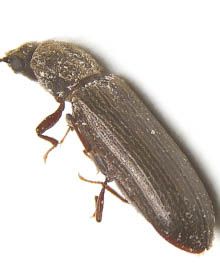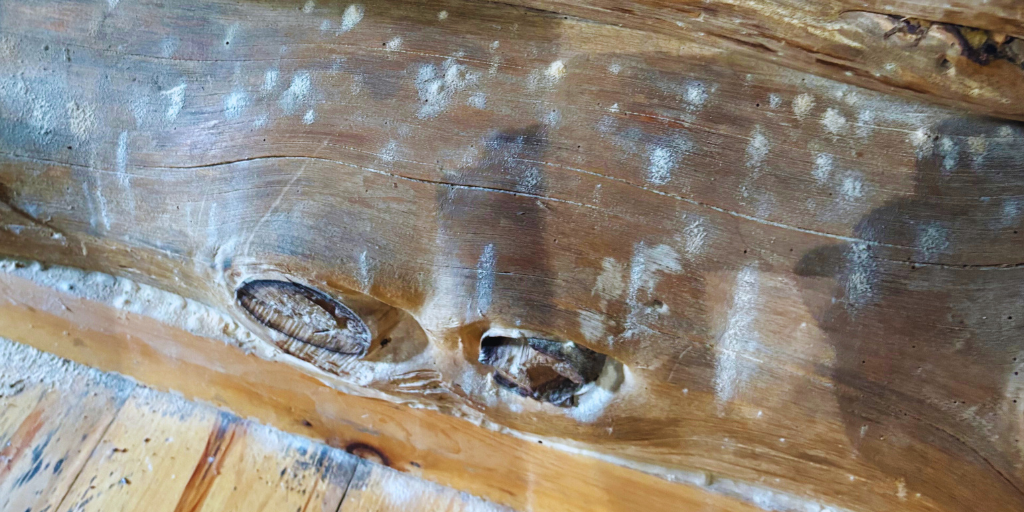PEST LIBRARY / BEETLES / POWDERPOST BEETLE
Powderpost beetles are small woodboring pests commonly found inside homes inside wood furniture, ornaments, flooring, moulding or panelling. These types of beetles bore into wood to lay their eggs within it. Once hatched, their larvae tunnel through it for months or years as they feed on the sapwood, which weakens the wood from the inside out.
You are actually more likely to see the damage they do to wood furniture and wooden structures that they infest, rather than the insects themselves. What’s most concerning is that you can have them for years and not know until an infestation is out of control and severe damage occurs.
Most powderpost beetles are inadvertently brought into homes, cottages or businesses, inside already infested finished wooden products or lumber. Using unfinished wood that was improperly stored outdoors (from barns or old woodpiles) for home DIY projects is a growing way these pests are
Powderpost beetles are not harmful to people or pets. They can severely damage wood, which can result in costly repairs if left untreated.
There are three main families of powderpost beetles:
Here in Ontario, Canada, Lyctid powderpost beetles and Anobiid powderpost beetles are the most common types.
While there are distinct differences between the various types of powderpost beetles, here are the most common characteristics and traits of these pests:

Powderpost beetles typically live in nature, inhabiting moist, dead wood. Depending on the beetle type, they will infest seasoned hardwood (oak, ash, mahogany, hickory, bamboo, etc.) softwood (fir, pine, spruce, etc.) and even plywood. They need wood with the right amount of moisture and starch content for their development cycle.
When found inside homes, cottages or businesses, they came in through already infested lumber or wooden furniture. Common places where they are found infesting indoors are in joists, rafters, flooring, and panelling.
Powderpost beetles are most active during spring and summer seasons. They overwinter in the wood they infest. During overwintering, they are inactive.
The powderpost beetle life cycle consists of four stages - egg, larva, pupa, and adult.
Powderpost beetles only emerge from the wood they infest as adults. The rest of their lifecycle takes place within the wood they inhabit. Typically, they produce a single generation per year.
In the spring, female powderpost beetles lay their eggs within the surface of the wood (inside tiny cracks & crevices and pores). Eggs typically hatch into larvae within a few weeks. The larvae will bore into the wood and spend the next two months to 1+ years feeding on the starch, sugar, and protein from the tree’s sapwood (which is the soft outer layer of wood found just below the tree’s bark). The type of wood, its moisture and humidity levels, and overall temperature can shorten or length their development process. To survive, powderpost beetle larvae need wood with a high moisture content, which is why old, untreated wood is commonly favoured.
When the larvae reach adulthood, they will exit the wood through small exit holes. Adults commonly live for 2-5 weeks, feed on plant-based materials like nectar and pollen, and focus the rest of their short lifespan on reproduction.
Once adult beetles emerge from the wood, they can and will re-infest the same wood by laying their eggs on the surface, therefore continuing their lifecycle.
Adult powderpost beetles do not eat wood, rather they feed on plant-based materials like pollen and nectar. Powderpost larvae consume sapwood, which is the living soft outer layer of the wood they infest. Powderpost pupae do not eat. This phase in their lifecycle is where they undergo a metamorphosis from larva to adult.
Yes, powderpost beetles cause damage, and this is why there is serious concern when they are found inside a home, cottage or business. If left untreated, they can cause structural vulnerabilities or total destruction.
While the adults may produce small round holes in the wood exterior (their exit holes) which don’t look ‘nice’, larvae can and will damage wood by boring and tunneling inside of it for years as they feed and develop into adults. During this time, the insides of wooden furniture, panelling, molding, flooring, joists, framing, crown molding, window frames and door frames are turned into a fine sawdust-like powder, destroying the structural integrity and resulting in costly repairs or replacement.
Lyctid powderpost beetles and Anobiid powderpost beetles are the most destructive of the powderpost family:
Important: Powderpost beetles do not deposit their eggs on painted, varnished, polished or waxed surfaces. If you discover powderpost beetle damage on finished wooden items, the infestation took place before finishing took place.
When it comes to determining if you have powderpost beetle infestation, there are three signs to look for:
Spaces like attics, basements, crawl spaces, and areas with exposed wood are the common places where powderpost beetles are found indoors. If high humidity is present in these areas, infestations can flourish.

When it comes to dealing with these types of woodboring beetles, no method of prevention is 100% guaranteed or effective. They can reside inside professionally cured and stored lumber and there is no way to know until damage has already begun to take place.
That being said, it is still important to be diligent and take steps to prevent powderpost beetles from getting inside your home, cottage or business. Here are some prevention tips from our pest control experts:
The optimal way to get rid of powderpost beetles is to prevent them in the first place by following the professional advice shared above. If you do end up having these woodboring beetles, partnering with an experienced pest control professional is essential.
Getting rid of them depends on so many factors - type of powderpost beetle, type of wood, location of the wood, level of infestation and how widespread it is, determining if they are active or not, level of damage, ability to pest proof/prevent, etc. An inspection from a pest expert is the first critical step to take to assess and understand the situation, determine how best to treat and devise an action plan.
The quicker you engage and consult with a pest control professional, the better the outcome. The damage that these insects are capable of is tremendous and it’s not visible/known until it is too late.
Since there are few signs of infestation and they hide deep inside wood unknowingly for years, Powderpost beetles can be tricky and challenging to eliminate. Working with an experienced professional, like an Environmental Pest Control licensed pest control Technician, is the best course of action to assess, understand and get control of the situation.
For powderpost beetle treatment to be effective, preparation is often always needed by the homeowner, property owner or business owner and the licensed pest control technician. It is important to keep this in mind, especially if you are seeking a quick and easy fix to a pest issue that is often tricky. The first step is an inspection and things will progress from that point on.
If you need help dealing with lyctid powderpost beetles, anobiid powderpost beetles, or bostrichid powderpost beetles, contact the experts at Environmental Pest Control!
NO RELIANCE ON PESTICIDE PRODUCTS - LEARN ABOUT OUR GREEN PEST MANAGEMENT SYSTEM